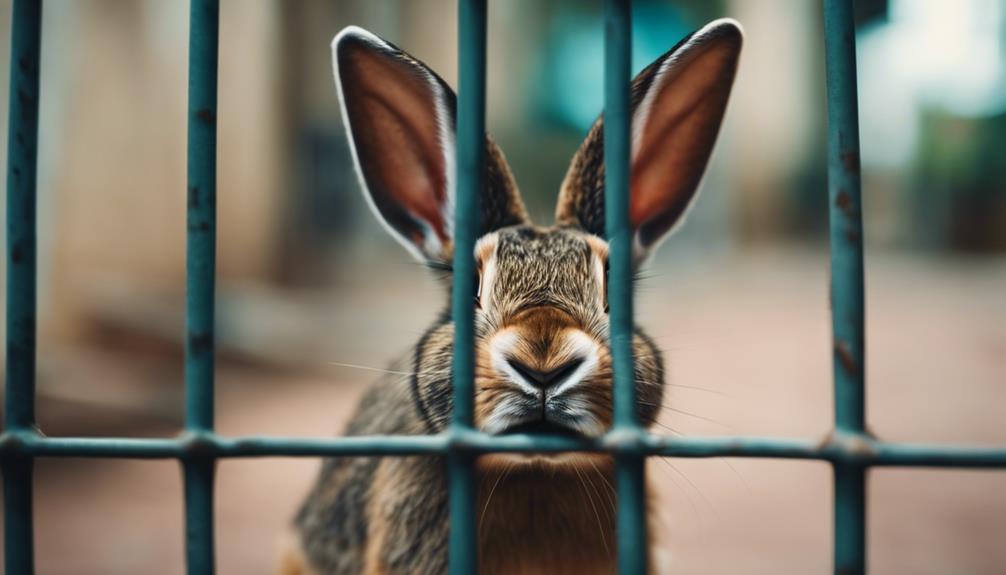When to Consider the Temperament of a Havana Rabbit

When to Consider the Temperament of a Havana Rabbit: Importance and Benefits.
Understanding their behavior can enhance the bond between owner and pet, leading to a more fulfilling experience for both.
Importance of Understanding Temperament
Understanding the temperament of a Havana rabbit is essential for fostering a harmonious and fulfilling relationship between the rabbit and its owner. The temperament of a Havana rabbit plays a crucial role in determining how it responds to various situations, interactions, and environments.
By comprehending the unique temperament of this breed, owners can anticipate the rabbit's behavior towards handling, socialization, and training. This understanding enables owners to tailor their care approach to meet the specific needs of the Havana rabbit effectively.
Moreover, considering the temperament of the rabbit enhances the bonding experience between the owner and the pet, facilitating better communication and strengthening the relationship. Therefore, investing time and effort in learning about the temperament of a Havana rabbit is fundamental for providing appropriate care, ensuring the rabbit's well-being, and building a strong and trusting bond with the companion.
Behavioral Cues to Watch For

When observing a Havana rabbit, it's crucial to pay attention to their body language signals, vocalizations, and social interactions.
These behavioral cues provide valuable insights into the rabbit's emotional state and well-being.
Understanding these cues can help caretakers create a supportive and comfortable environment for their Havana rabbit.
Body Language Signals
In observing a Havana rabbit's body language signals, one can interpret various behavioral cues to understand the rabbit's emotional state.
- Tail position: A raised tail can indicate excitement or aggression, while a lowered tail suggests relaxation or fear.
- Ear movement: Ears that are perked up may mean curiosity or alertness, while ears laid flat could signal fear or submission.
- Body posture: A bunny standing on its hind legs may be exploring or feeling threatened, while a relaxed, stretched out body indicates comfort.
- Teeth grinding: Grinding teeth can show contentment, but loud teeth grinding may indicate pain or discomfort.
- Grooming behavior: Excessive grooming or pulling out fur can be a sign of stress or illness in Havana rabbits.
Vocalizations and Sounds
Considering the body language signals of a Havana rabbit provides valuable insights into their emotional state. Similarly, understanding their vocalizations and sounds offers additional behavioral cues to watch for.
Havana rabbits are generally quiet creatures but may softly grind their teeth when content. Subtle thumping sounds with their hind legs can indicate mild agitation or alertness. Loud squealing or high-pitched shrieking may signal extreme fear, pain, or distress, while purring or gentle tooth-clicking can signify relaxation and contentment.
Any sudden changes in vocalizations should be noted as they could indicate potential health or emotional issues in Havana rabbits. Being attuned to these vocal cues can help rabbit owners better understand and care for their furry companions.
Social Interactions Importance
Social interactions among Havana rabbits provide crucial insights into their well-being and emotional state. When observing these interactions, watch for signs of aggression or fear, both towards other rabbits and humans.
Pay attention to body language cues such as thumping, boxing, or hiding, as these behaviors may indicate discomfort or stress. Note how the rabbit responds to handling, petting, and being picked up to gauge their comfort levels in social situations.
Additionally, monitor the rabbit's eating habits for any changes, as alterations in appetite or behavior could signal underlying stress or health issues.
Lastly, be attentive to the rabbit's vocalizations, such as grunting or teeth grinding, as these may indicate discomfort or distress during social interactions.
Socialization With Other Pets

Havana rabbits can form harmonious relationships with other pets, particularly with animals that possess a calm and non-threatening demeanor like cats or gentle dogs.
The key to successful socialization lies in gradual introductions and close supervision to ensure the well-being of all animals involved.
Monitoring interactions closely and intervening at the first sign of aggression or stress is essential for fostering positive relationships between Havana rabbits and other pets.
Rabbit-Pet Interactions
When introducing a Havana rabbit to other pets in the household, gradual and supervised interactions are crucial for ensuring a safe and positive relationship development. Havana rabbits, known for their sociable nature, can interact well with other pets like cats and dogs when properly introduced.
Here are some key points to consider for successful rabbit-pet interactions:
- Supervision: Always monitor interactions between the Havana rabbit and other pets.
- Prevention of conflicts: Take steps to prevent any potential conflicts during introductions.
- Slow introductions: Gradual introductions help establish positive relationships over time.
- Monitoring behavior cues: Pay attention to body language and behavior cues from all animals involved.
- Creating positive experiences: Reinforce positive experiences to build trust and camaraderie between the Havana rabbit and other pets.
Behavioral Compatibility
Considering the importance of behavioral compatibility in fostering positive relationships between pets, supervised interactions play a pivotal role in determining the harmonious coexistence of a Havana rabbit with other household animals. Havana rabbits are social creatures that can get along well with other pets, such as cats or dogs, when introduced properly.
Slow introductions are recommended to assess behavioral compatibility and allow the animals to form bonds over time. It's crucial to monitor these initial interactions closely to ensure positive engagement and a harmonious relationship between the Havana rabbit and other pets. By conducting behavioral assessments and facilitating supervised interactions, pet owners can promote a safe and positive environment for their Havana rabbit and other household animals to thrive together.
Handling Introductions
To ensure a smooth integration process, gradual socialization with other pets is key when introducing a Havana rabbit into a new environment. It's essential to monitor their interactions closely and be mindful of their body language and behavior during introductions. Here are some important considerations for handling introductions:
- Observe their initial reactions: Pay attention to how both the Havana rabbit and the other pets respond to each other.
- Create a safe environment: Ensure the space is secure and free of potential hazards for all animals involved.
- Allow for supervised interactions: Be present to intervene if necessary and guide positive interactions.
- Seek professional advice if needed: If there are concerns about compatibility, consult with an expert for guidance.
- Prioritize the well-being of all pets: Make decisions that promote safety and harmony among the animals.
Handling and Bonding Tips

Regular handling of a Havana rabbit from a young age is crucial for building trust and strengthening the bond with these calm and affectionate creatures. Havanas, known for their gentle temperament, thrive on socialization and human interaction. Regular handling sessions, involving gentle petting and cuddling, are essential to foster their affectionate nature. By understanding and respecting the individual personalities of Havana rabbits, owners can tailor their approach to bonding with these unique pets.
Bonding with a Havana rabbit involves creating a safe and comfortable environment where they feel secure. Owners should approach them calmly and steadily to establish trust gradually. Consistency in handling routines and interactions aids in building a strong bond with these sociable creatures. It's important to be patient and allow the rabbit to dictate the pace of the bonding process. By engaging in regular handling sessions and providing positive reinforcement, owners can cultivate a deep and meaningful connection with their Havana rabbit.
Signs of Stress or Discomfort

When observing a Havana rabbit, it's crucial to watch for subtle signs indicating stress or discomfort. Signs of stress in Havana rabbits may not always be overt, so being attentive to their behavior is essential.
Here are some key indicators to look out for:
- Decreased activity levels: If a Havana rabbit is less active than usual, it could be a sign of stress.
- Changes in eating habits: Monitor any shifts in eating or drinking patterns, as these could indicate discomfort.
- Hiding behavior: Excessive hiding or avoiding interactions may signal that the rabbit is feeling stressed.
- Vocalizations and teeth grinding: Unusual sounds or teeth grinding could be signs of stress or discomfort in Havana rabbits.
- Grooming habits: Pay attention to any changes in grooming behavior, as increased grooming or self-soothing behaviors may indicate stress.
Incorporating Enrichment Activities

Enrichment activities play a vital role in enhancing the mental and physical well-being of Havana rabbits. Providing a variety of enrichment activities such as toys, tunnels, and puzzle feeders is essential to prevent boredom, encourage natural behaviors, and promote overall well-being. Interactive playtime and training sessions not only keep Havana rabbits engaged and stimulated but also help strengthen the bond between owners and their pets.
These activities aren't merely for entertainment; they serve a crucial role in maintaining the mental health of Havana rabbits. By engaging in enriching tasks, these rabbits can reduce stress, prevent behavioral issues, and lead happier lives. Incorporating enrichment activities into their routine is a proactive way to ensure their physical health as well. Through these activities, Havana rabbits can exercise, stay mentally sharp, and avoid the negative effects of a sedentary lifestyle.
Seeking Professional Guidance

Wondering how to address significant changes in your Havana rabbit's temperament? Seeking professional guidance is crucial when dealing with behavioral issues. Here are some key points to consider:
- Consulting with a rabbit behavior specialist can provide valuable insights into your Havana rabbit's behavior.
- Seeking guidance from a veterinarian experienced in rabbit behavior is essential if your rabbit displays signs of aggression or fear.
- Professional advice can help identify and address any underlying health issues affecting your rabbit's temperament.
- Training sessions with a rabbit behavior expert can enhance your understanding and improve your rabbit's behavior.
- Professional intervention may be necessary if your rabbit's temperament poses a risk to its well-being or the safety of others.
Prioritizing your Havana rabbit's well-being and safety is paramount, and seeking professional guidance ensures that you address any behavioral issues effectively. Remember, professional guidance can make a significant difference in enhancing your rabbit's quality of life.
Frequently Asked Questions
What Is the Temperament of a Havana Rabbit?
Havana rabbits have a calm, sweet temperament, enjoying social interaction and easily bonding with humans. Their playful nature makes them ideal companions for families. Understanding their temperament is crucial for proper care and meeting their social needs.
What Is the Desired Temperament for Rabbits?
The desired temperament for rabbits includes being gentle companions, playful interaction, trust building, socialization skills, and displaying behavioral cues. It's crucial for rabbits to enjoy bonding processes, practice training techniques, and communicate effectively to build a strong relationship with their caregivers.
What Are the Calmest Bunny Breeds?
Among the calmest bunny breeds are lop-eared bunnies, miniature rabbits, and lionhead breeds. Also, dwarf rabbits, Flemish giants, and English rabbits are known for their gentle temperaments. Angora bunnies, Netherland dwarfs, Rex rabbits, and Californian breeds exhibit docile behavior.
What Is the Temperament of a Domestic Rabbit?
Understanding a domestic rabbit's temperament is essential. It influences handling techniques, socialization methods, training tips, bonding activities, enrichment ideas, communication cues, stress indicators, aggression triggers, temperament testing, and behavioral adjustments. Owners must be attuned to their rabbit's unique personality for optimal care.









